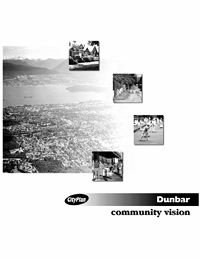No Light Rail in Vancouver!
Anti-

The American Planning Association celebrates November 8 as “Town Planning Day,” so
the Antiplanner will celebrate calendrically opposite May 8 as “Anti-

Vancouver skyline. Flickr photo by mureena.
First up is Vancouver, BC, a city of 580,000 people. Under British Columbia law, every city in the province must have a city plan, and those plans must meet a variety of goals, including supporting “the unique character of communities.”
To implement this law, Vancouver planners have divided the city’s residential areas into nine communities and have written “community visions” for each community. Each community vision proudly states that it was “developed by people who live and work” in each community. That is misleading at best.
Click on either cover to download a copy of either community vision.
As shown above, the covers for the community visions are remarkably similar. In fact,
the similarities are more than just cover-
At more than 13,000 people per square mile, Vancouver is already denser than Chicago,
the third densest major city in the U.S. Vancouver is the densest major city in Canada;
the only Canadian city of any size that is denser is Westmount, a suburb of Montreal.
(Suburbs can sometimes be denser than central cities if they have little land devoted
to commercial, industrial, or other non-
Yet Vancouver planners seem to be in a frenzy to impose higher densities on their
communities. The community visions plan “rowhouses, four-


Infill in the Cedar Cottage neighborhood. Flickr photos by roland.
How were these visions written? It turns out that the city planning department wrote all of the visions ahead of time. They then went to each community and asked some of the residents how they felt about each part of the vision. Of course, they didn’t say things like, “Do you want to let your neighbours rent out a part of their homes to transients, including potential burglers and drug users?” Instead, they said things like, “Do you want to let your neighbours rent out a part of their homes to help them pay their mortgages and provide more affordable housing?”
Even with such favorable wording, some of the communities rejected some of the planners’
visions. The Victoria-
Reputable polls show that more than 70 percent of Canadians aspire to live in single-
I think the answer is partly because most of the people who planners are surveying
already live in single-
No one who reads this blog will be surprised that, after years of this kind of planning,
Vancouver planners have succeeded in making Vancouver’s housing the least affordable
in Canada. The average unit of housing in Vancouver costs more than seven times the
median family income, which puts it right up there with London and San Jose. Moreover,
that’s counting condos and other multi-
The Antiplanner thinks the priorities of Vancouver planners are seriously warped. They are desperately trying to protect open space in a province that has some of the lowest overall population densities in the world (only 14 of 230 countries have lower densities). In their efforts to impose as many kinds of density as possible on various communities, they are destroying the unique character of those communities.
In one sense, Vancouver represents undemocratic town planning at its worst. Yet this flawed process is inevitable whenever you give someone the power to plan someone else’s neighborhood.
0
Trackback • Posted in City planning
Reprinted from The Antiplanner

